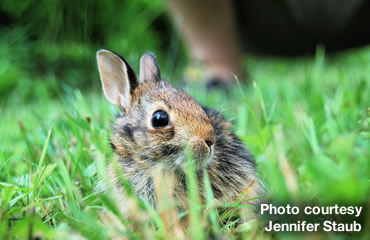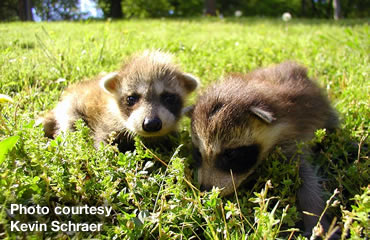Photo: The best way to deal with the baby animal you believe is an orphan is to leave it alone.
It’s as predictable as the arrival of spring.
You’ve found a baby bird or perhaps a fawn or, maybe, a clutch of very young rabbits. You worry because the baby or babies are all alone. You look around and there’s no sign of where the adorable little ones may have come from.
What should you do?
Most well-intentioned people want to rescue the seemingly abandoned little ones, but they may not realize they’re actually taking them from their mother who left them there to forage for food.
Well-meaning people often make incorrect assumptions when they happen to come across young birds or animals. Some call a wildlife rehabilitator; others call their local state natural resources office. Still others take them home to “save them.”
Wildlife experts say the best way to deal with the baby animal you believe is an orphan is to leave it alone.
"People should keep their interactions with wildlife to a minimum," said Mark Howery, Wildlife Diversity senior biologist with the Oklahoma Department of Wildlife Conservation. "Normal wildlife behavior is often misinterpreted as something abnormal by well-meaning people, and it usually does more harm than good when people intervene."
The majority of encounters with young wildlife are nothing to be concerned about.
 Many animals try to hide their young and tend to them periodically through the day. They leave them alone for much of the time so they won’t call attention to the young or create a scent trail that might lead predators to them.
Many animals try to hide their young and tend to them periodically through the day. They leave them alone for much of the time so they won’t call attention to the young or create a scent trail that might lead predators to them.
Chances are the parents are watching them from a distance or are nearby eating or gathering food and will return to their young.
"Every spring, we receive many calls from people who have found a young animal hiding in the grass, or some other animal that they think might need help," Howery said. "People are often inclined to intervene, but they should refrain."
Too often the best of human intentions actually harms young wildlife.
“Well-meaning citizens sometimes make it harder for wildlife to survive by picking them up or interfering with their natural surroundings,” says Maryland’s Wildlife and Heritage Service Director Paul Peditto. “Unnatural conditions of life in captivity can lead to malnutrition, injury and stress at the hands of well-meaning captors. Wild animals that become accustomed to humans can pose health risks to people and pets and become dangerous as they mature.”
Late spring is the prime birthing time for white-tailed deer, and Peditto reminds those who encounter a fawn to avoid disturbing it. While young deer often appear to be orphaned, in most cases the doe is nearby feeding and will return to care for her young.
Newborn fawns have almost no natural odor and their spotted, reddish-brown coats help them blend into their surroundings. Fawns instinctively lie motionless when approached by potential predators. This seemingly helpless state is a behavioral adaptation that has helped white-tailed deer survive for ages.
However, curious fawns will sometimes wander around new surroundings and may appear to be lost or distressed.
Too often, people find and remove fawns from the wild, believing they are helping an orphaned animal, when in fact they may be causing great harm. For the safety of both humans and wildlife, removing deer from the wild and keeping them in captivity is against the law in many states.
But, but . . . what if you find a baby bird that seems to have fallen from its nest? Isn’t that different?
 It’s not unusual, and many birds often leave their nests before they are able to fly.
It’s not unusual, and many birds often leave their nests before they are able to fly.
"They usually spread along the branch of a tree and chirp and call, waiting for their parents to bring food to them," says Blair Stringham, who is the migratory game bird program coordinator with the Utah Division of Wildlife Resources. "Sometimes, that results in them falling from their perch."
He also offers some common sensible advice.
If the bird is very small and still featherless, you should place it back in its nest if possible. If you can't find the nest, put the bird on a branch safely out of reach of dogs and cats. "The baby will squawk and its parents will find it," Stringham said.
Don't be concerned about leaving your scent on the bird. Most birds do not have a good sense of smell so if you pick up a baby bird, its parents won't even know you've handled it. And, never take a baby bird home. Most birds are protected by state and federal laws, and it is against the law in many states to possess wild animals without special permits.
Do not feed the bird. While it's fine for its parents to feed the baby bird, you shouldn't attempt to give it food. Birds have a very specific diet and feeding them something that's not part of their diet can kill them.
"For example, many people are surprised to learn that robins are among only a handful of birds that can safely eat worms. Most birds can't," Stringham said. Just place the bird back on its branch or in its nest, and let its parents feed it.
If the baby bird is hopping around, you've found a bird that almost isn't a baby. These young birds are fledglings. They have most of their flight feathers and are very close to taking their first flight. Just leave it alone.
If the bird isn't in danger, leave it where you found it. This awkward hopping stage typically lasts two to five days. It's part of the natural process a baby bird goes through before taking its first flight. Its parents are watching and are still feeding it.
If you think the fledgling is in immediate danger, then move it carefully to a safer spot nearby. However, if you can't catch the bird, stop your attempt.
The best advice when it comes to finding any unattended wildlife baby is simple. In the words of Paul McCartney of Beatles fame, just “Let it Be.”
–Resources: Maryland Department of Natural Resources, Oklahoma Department of Wildlife Conservation, Utah Division of Wildlife Resources.